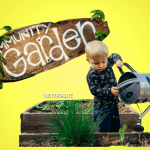(Psst: The FTC wants me to remind you that this website contains affiliate links. That means if you make a purchase from a link you click on, I might receive a small commission. This does not increase the price you’ll pay for that item nor does it decrease the awesomeness of the item. ~ Daisy)
By the author of the FREE online course Growing Self-Sufficiency: The Whole Picture
More and more people are facing significant financial struggles that are making it difficult to buy enough food. If you are in that situation, this article is for you. While there are many resources that are known to be helpful for folks during difficult times, such as local food banks, there are also many informal, or unpublicized, sources of help. In my own life, during difficult times, I have found a great deal of hope through the kindness of strangers helping others in need. It is my desire that this article will help some folks find food and a similar kind of hope.
This article will offer ideas on how to access both food banks and other “hidden” possible sources of food if you are finding yourself short on money for basics. You will notice that I stay away from government-sponsored programs and focus on some of the expected and unexpected creative sources for help. I think that most folks are familiar enough with these or know where to find out more information if they need to. Although the resources I describe are local to me, I am hoping there will be similar supports or others in your area.
Tips for maximizing your benefit from food banks
Clarifying Access Policies: If you are really in need, being able to access more than one food bank can be a big help. Within a 20 to 30-minute drive of where I live, there are at least four or five food banks available in small villages. As far as I am aware, none of them have a residency requirement that would not permit someone from a neighboring village to seek help.
I have heard in the larger city around an hour from here, being a resident of that city may be required, proven with identification. Our local townships all have directories of these food banks online. If you are in need of food through a food bank, it could be worth your time to clarify which one/s you qualify for and how often you can access them. Who knows? A few phone calls may lead to doubling your access to food support this month.
Prioritizing Your Access to Shopping Type Food Banks: What do I mean by that? Many food banks only offer a pre-packed box of items, which is selected based on how many people in the household. If you have a special diet or are in need of baby foods, for example, this lack of flexibility may mean you end up with items that you cannot eat or use.
In our area, one food bank is a “shopping” type of food bank, where you get a certain number of credits and can use them in different areas of the food bank, like frozen foods, pasta/grains, fresh dairy items, and canned goods. Each client is allowed a certain number of credits, depending on the size of his or her household.
If you are fortunate enough to access a “shopping” type food bank, make sure you understand how many credits you get and where you can spend them. Don’t be afraid to ask some questions before you begin shopping. Are there any “free” items available that don’t require credits? You may be able to freeze some of these or save them for weeks when you have more need.
In my research for the article, I was told by volunteers at our local “shopping” food bank that pantry staples are accessed much less often than prepared foods. For this reason, they offer things like bags of beans and rice for very few credits. By choosing unprepared foods like that, you could actually get much more food for your household for one trip to the food bank.
One village around an hour from here does not maintain a food pantry. Instead, clients are given vouchers to shop at the local grocery store. There is another food bank around 15 minutes from here with a similar program. If you have unique needs or want to maximize the food you get by buying completely unprocessed foods, it is worth trying to locate a food bank with a similar approach.
Non-food bank sources of food
Community Gardens: This time of year, we have community gardens sprouting everywhere in our region. Within the same driving distance, there are at least four. One of them is connected with the food bank I described above. Another is located at a local community health center. All of them are often short of volunteers. Locating a contact for gardens like these may be difficult. If you see one in your area, you could simply stop by and ask who is in charge and how you could get involved. For a minimal investment of your time, you can help the group maintain the garden and reap the benefit as the garden grows.
If you have physical challenges, there may be tasks for you, too. One community garden I participated in had a wheelchair-accessible raised bed. Perhaps you could prepare a snack for everyone on a workday. You will never know if you don’t ask!
Churches: One church in a local village offers a fund for families in crisis separate from its food bank service. Another church is well-known for being willing to jump in if a family has a sudden, unexpected financial need, such as a broken washing machine in a low-income household with young children. In my own experience here, I have seen that churches vary in their willingness to reach beyond the boundaries of their own members with kindnesses like this. Through word of mouth and by asking, you could identify some crucial help for you and your family.
Church-run Thrift Shops: Only about 15 minutes from where I live, a local church runs a thrift shop next to the grocery store. In there, you will find relatively low prices for items in need, such as basic kitchen items like dishes, and a huge range of children’s items like clothing, cribs, and toys. To a large extent, these items are priced based on people’s ability to pay. As well, the church has an emergency food bank pantry available right in the thrift shop.
Informal Food Banks: In our area, there are two of these informal food banks. One is in the entranceway of our local community health center. There is a small table and a sign that invites people to “leave what they can and take what they need.” I generally see several cans and boxes available when I enter this health center.
Similarly, our local post office has one in the main area where people access their mailboxes. A used outdoor magazine box is designated for non-perishable food items. If such a service doesn’t exist in your area, perhaps you could find a way to create one? If you are receiving items from a “pre-boxed” type of food bank that you cannot use, this would be a great way to share them with others.
Volunteering for Food: Most food banks in our area are run by volunteers and would welcome another pair of hands on deck, so to speak. In my experience, volunteers may be offered some bonuses in gratitude (this may depend on the program!). For example, in one food bank where I volunteered in a large city, volunteers were offered some special items after a shift that there were not many of. One night, we were offered a beautiful frozen fish!
In the church-run thrift shop I described above, all staff are volunteers. For each four-hour shift, they are offered a delicious bag lunch that includes a meat sandwich with real cheddar cheese. In addition, they are able to select a certain amount of the thrift shop merchandise for free as “payment” for their shift.
Community-Health Centre Support: In a previous article, I have described the potential benefits of cooperative food-buying groups. Our local community health center has a budget to cover the cost of a Good Food Box for folks who are in need. This provides a huge boost for any household, with the many fresh fruits and vegetables it contains.
Help is available, often in unexpected places
With our food dollars shrinking, many households need to find assistance to buy their food. Have you ever been in this situation? Could you see yourself trying any of the ideas for the help offered here? Do you have an idea you can share with us? Please tell us in the comments below.
About Colette
Colette is passionate about sharing her knowledge of thrifty living and self-sufficiency. She has developed her skills in self-reliance living in the suburbs, the city, and more recently, on her own Half-Acre Homestead. Colette lived five years completely off-grid and without running water in an eight by 24 foot tiny home while designing and building her own 18 by 24-foot eco-cabin. Her website, Half Acre Homestead is attracting followers from around the world who want to become more self-sufficient. Colette invites you to stop by the Homestead and check out all of the great resources including the practical How To Guides, A Tiny Home Resource Center and her organic gardening stories on her blog. She shares her wholistic model (body/mind/spirit) for achieving self-sufficiency in her Free Course, “Growing Self-Sufficiency: The Whole Picture.” Stop by the Homestead today to register free of charge!











15 thoughts on “Finding Food, and Hope, During Difficult Times”
One of the things that “we” do, is buy “broken rice” from the nearest Asian market. It’s less than presentation grade, but if you don’t care, it doesn’t matter.
That being said, it might matter to “them”. That meaning if you serve “broken rice” to some ethnic persuasions, it could be considered anything from embarrassing (to you) &/or insulting (maybe even “bad luck” to them). If nothing else, it’d be obvious to them that you’re experiencing “hard times”.
All of that being out there, all “broken rice” is, is all of the bits & pieces of, literally broken rice. It’s considered less than say restaurant quality, but for considerably less.
Hi Justin, Thank you for sharing this. I did not know about “broken rice.” What would matter to me is the savings it sounds like it represents! I am going to look into this. I find that rice can be a very good compliment to many kinds of meals I make to add some fibre and make them more filling. Much appreciated!
Yes, it’s like half price. If you were going to make something like beans & rice burritos they’re going to be all rapped up anyway.
It’s been awhile, so don’t quote my pricing here, but you could probably get something like 20-25lbs for $15 +&/or-
Hi Justin, I’m less familiar with rice prices in the US, so thank you for sharing that for all the Frugalite readers there. In Canada, a pretty standard rice price for a bulk bag of 10 pounds would be $1 Canadian per pound, so I’m not sure what that is for an American dollar, maybe 75 cents? So, buying a lot of broken in rice in bulk does sound like a great deal. Thanks again!
I’ve seen 5lbs for $15 at a local Vietnamese grocery store.
If you live in an area with produce rescue, this can be an awesome option. Borderlands is one such organization, and they will give a huge box of rescued produce to anyone who volunteers. It’s only a few hours on a Saturday too so it’s not even a huge time commitment. In my area, at times when it’s available, you can get 70 pounds of rescued fruits and vegetables for about $15 even if you don’t volunteer. The varieties will vary a lot but the place I use sends out an email each week telling the varieties and pick up locations. I’ve gotten some really nice organic items too, it’s not all stuff that’s about to expire.
Hi Redbranch, Wow! What a fantastic resource! I love that this is another example of how a few volunteer hours can go a looooong way to providing food for a family. In my area, we do have organizations that rescue food from probably similar places, like grocery stores and the like. However, rather than being sold to the public, these services direct them to soup kitchens and shelters. I have checked out there website and could not be more impressed with the work that Borderlands is doing. What an inspiration! Thanks for sharing such a great idea with everyone. Wishing you the best!
The organizations I’m thinking of primarily rescue from local farmers with extra crops so it’s a bit different than a rescued groceries type of place – I actually love it. 🙂 I love anything that reduces waste while saving money!
Hi Redbranch, Right, I see what you mean about the source of food (farmers vs. grocery). Yes, I agree about reducing waste! One fall, I saw a field locally with many large squash. I had tried to reach out to the farmer to get a gleaning crew out there, but the next day, it was all plowed under. With a volunteer team at the ready, I’m sure many such fields could be saved out there. Wishing you the best!
There is a great business about an hour from my home. It is a nursery of sorts. The owner propagates all kinds of vegetable and native plants. He is open all the time, prices are low and payment is on the honor system. However the best thing is that all of his employees are volunteers that get “paid” in plants. Anyone can go to work on their own schedule. Repotting seedlings or sorting pots and get paid by the hour in plants of their choosing.
Hi Krista, Oh WOW! You know, I would love to start something like that. Every year, my Half-Acre Homestead donates seedlings I start myself to local community gardens (and often seeds). However, how wonderful to bring like-minded people together for such a great cause. I am on the look for a plot of land to start a new community garden in our own village. Perhaps I can also give some thought to this venture. Thank you so much for sharing this! Wishing you the best!
A church that I attended in my previous city had tables set out in the foyer of the activities building where people would put out their excess produce for anyone to take. It was a great thing for those who couldn’t garden and wanted fresh vegetables and fruit. I congratulated one gardener on leaving the greens on the beets and discovered that she had never cooked beet greens and just hadn’t bothered to cut them off. She later told me that she and her husband now considered beet greens as a favorite cooked green.
Hi Mary, Thank you for sharing such a great story! That church was quite inspired. There are so many gardeners with extras who would love to see it go to those in need. I absolutely LOVE beet greens, too. How nice that you were able to teach that gardener about how great they are. I’m sure she might think of you from time to time as she enjoys them with her husband! Wishing you the best!
In our small town there are usually 1 or 2 free meals offered to the general public each week. Prepared by and served at local churches, sometimes there is music or other frivolity going on. It’s a full meal – pasta with meat sauce, roast beef and mashed potatoes, hearty soup and bread, even Thanksgiving dinner. Most offer take home boxes if you have someone who can’t get out.
These won’t stock your pantry but they will fill your stomach and take some pressure off your pantry.
Hi Polly, I very much appreciate your sharing your own experience in your small town. Just today, I was at the local church-run thrift shop, and they are offering cold plate boxes through the summer months. There’s a few cold cuts in them, a cold boiled egg, some pickles, and a few cold summer salads, like potato, macaroni and the like. They are so generous to make these, and they could be stretched across a few meals with a few added extras from a small garden, for example. At the entranceway of the thrift shop is a beautiful dorm sized fridge with many vegetables and herbs shared by local gardeners. Between the two, folks can get some much needed help. I’m glad to hear that you’ve got some kind hearted folks in your town, too. Thanks so much for sharing. Wishing you the best!